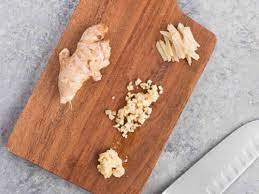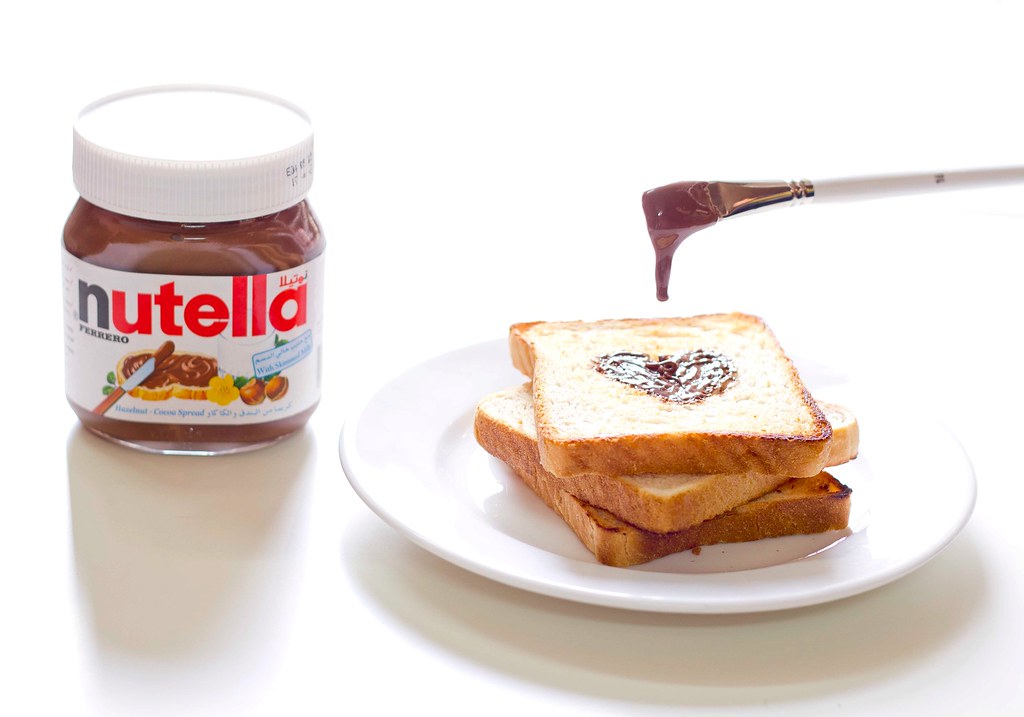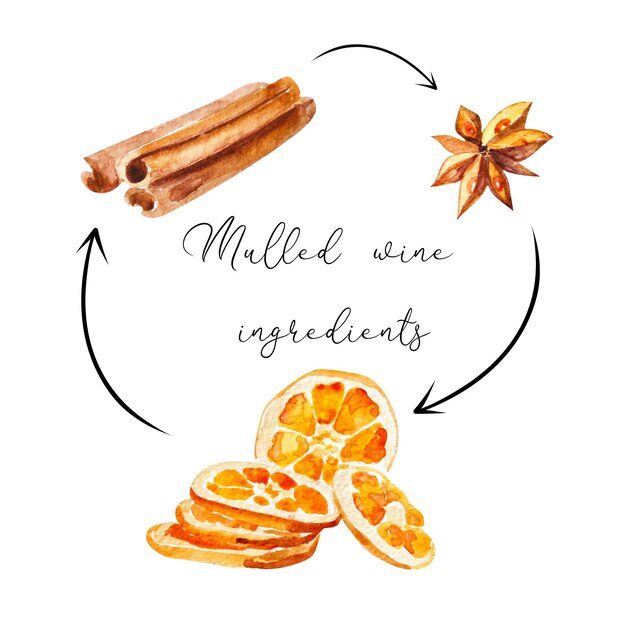Simple and Effective Techniques for How to Mincing Ginger like a Pro
Ginger is a versatile spice that adds a unique flavor and aroma to dishes. It is an essential ingredient in many cuisines around the world. However, mincing ginger can be a bit challenging if you don’t know the proper technique. In this step-by-step guide, we will show you a simple and efficient method for mincing ginger.
First, you will need to gather the necessary ingredients and tools. You will need fresh ginger root, a sharp knife, and a cutting board. It is important to choose ginger that is firm and has smooth skin. Avoid ginger that feels soft or has wrinkled skin.
To begin, peel the ginger root using a vegetable peeler or the edge of a spoon. The skin of the ginger is quite thin, so it should come off easily. Once the ginger is peeled, you can start mincing it.
Hold the peeled ginger firmly and place it on the cutting board. Using a sharp knife, make thin slices of the ginger. Be sure to slice against the grain of the ginger to get the best texture. After making the slices, gather them together and stack them on top of each other.
Next, cut the stacked ginger slices into thin strips. Hold the strips together and chop them into smaller pieces. Continue to chop until the ginger is minced to your desired consistency. You can make the ginger mince as fine or as coarse as you prefer.
Once the ginger is minced, you can use it in your recipes. It adds a burst of flavor to stir-fries, marinades, dressings, and more. If you have any leftover minced ginger, you can store it in an airtight container in the refrigerator for up to a week.
In conclusion, mincing ginger doesn’t have to be a difficult task. With this simple method, you can easily and efficiently mince ginger for all your culinary creations. Enjoy the vibrant and aromatic taste that ginger brings to your dishes!
Overview of Mincing Ginger
Mincing ginger is a common technique used in many cuisines around the world. Ginger is a versatile root with a unique flavor that adds a spicy and refreshing taste to dishes. Mincing ginger involves finely chopping the root into small pieces to maximize its flavor and incorporate it evenly into recipes.
Ginger is known for its health benefits, including its anti-inflammatory properties and ability to aid digestion. By mincing ginger, you can release more of its natural oils, enhancing its taste and providing more health benefits.
When mincing ginger, it’s essential to choose fresh, firm roots that are free from mold or soft spots. The skin can be easily removed with a peeler or a spoon, revealing the vibrant yellow flesh underneath.
To mince ginger, start by slicing it into thin discs. Then, stack the discs and cut them into matchsticks or thin strips. Finally, dice the strips finely until you achieve the desired mince. Alternatively, you can use a grater or a food processor to mince ginger more quickly and uniformly.
Minced ginger can be used in a wide range of dishes, from stir-fries and curries to salad dressings and marinades. It adds a delicious kick to soups, sauces, and even beverages like ginger tea or smoothies. Plus, minced ginger can be stored in an airtight container in the refrigerator for up to a week, making it convenient to have on hand for various recipes.
In conclusion, mincing ginger is a straightforward process that allows you to unlock the full potential of this versatile root. Whether you’re a seasoned chef or a home cook, adding minced ginger to your culinary repertoire will elevate the flavors of your dishes and provide numerous health benefits. So next time you’re in the kitchen, don’t forget to grab a fresh ginger root and give it a mince!
What is Mincing?
Mincing is a culinary technique that involves finely chopping food into small, even pieces. It is commonly used with aromatic ingredients such as garlic, onions, and ginger to release their flavors and incorporate them more evenly into dishes. Mincing ginger, in particular, is a prevalent technique in Asian cuisine, where ginger is widely used as a spice and flavor enhancer.
To mince ginger, you need to remove the outer skin and then chop it into very small pieces. The size of the minced ginger can vary depending on the recipe, but it is generally minced into small, consistent cubes or tiny shreds. Mincing ginger helps to distribute its distinctive taste throughout the dish, adding a unique flavor dimension to various Asian-inspired recipes.
Additionally, mincing ginger allows it to release more of its aromatic oils, enhancing the scent and taste in the cooking process. This technique ensures that the ginger is evenly distributed, preventing overpowering bites of ginger in some areas and none in others.
Overall, mincing is a valuable skill when it comes to ginger and many other ingredients, as it can enhance the texture, flavor, and overall enjoyment of a dish. Whether you are cooking a stir-fry, making a marinade, or adding ginger to a soup or sauce, mincing is a useful technique to master.
Importance of Ginger in Cooking
Ginger is a widely used spice in various cuisines around the world. Not only does it add a unique flavor and aroma to dishes, but it also offers numerous health benefits. From its distinct taste to its medicinal properties, ginger has become an essential ingredient in many kitchens. Here are a few reasons why ginger is important in cooking:
1. Flavor Enhancer
Ginger has a warm and slightly spicy flavor that can enhance the taste of both sweet and savory dishes. Whether you are making a stir-fry, soup, curry, or even baking cookies, adding a touch of ginger can elevate the overall flavor profile of the dish. Its zesty and tangy notes bring a refreshing and aromatic element to the food, making it more appetizing.
2. Digestive Aid
Ginger is renowned for its digestive properties. It has been used for centuries as a natural remedy for indigestion, nausea, and other gastrointestinal issues. Incorporating ginger into your cooking can help stimulate digestion, reduce bloating, and alleviate stomach discomfort. It can also be consumed as a soothing ginger tea after a heavy meal to aid in digestion.
3. Health Benefits
In addition to being a flavor enhancer and digestive aid, ginger offers various health benefits. It is packed with antioxidants that help boost the immune system and fight inflammation in the body. Ginger has also been found to have anti-nausea properties and may help reduce muscle pain and soreness. Regular consumption of ginger can contribute to overall well-being.
Conclusion:
Ginger is not only a versatile and delicious spice but also a powerful medicinal ingredient. Its unique flavor profile, digestive properties, and health benefits make it an important addition to many culinary creations. By incorporating ginger into your cooking, you can not only enhance the taste of your dishes but also promote better digestion and overall health.
Benefits of Mincing Ginger
Ginger has been used in traditional medicine for thousands of years due to its numerous health benefits. When ginger is minced, its active compounds are released, making it even more potent and effective in promoting health and wellness.
1. Digestive Health
Mincing ginger enhances its ability to aid digestion. Ginger contains gingerol, a compound that stimulates the production of digestive enzymes, improves nutrient absorption, and relieves various digestive issues, such as nausea, bloating, and indigestion.
2. Anti-Inflammatory Properties
Gingerol, the main bioactive compound in ginger, has powerful anti-inflammatory properties. Mincing ginger releases more gingerol, allowing it to better reduce inflammation in the body. This can be particularly beneficial for those suffering from conditions such as arthritis, muscle pain, and inflammatory bowel disease.
Pro Tip: To further enhance ginger’s anti-inflammatory properties, combine minced ginger with turmeric, another potent anti-inflammatory spice.
3. Immune System Boost
Ginger is known for its immune-boosting properties. It contains antioxidants that help protect the body against oxidative stress and strengthen the immune system. Mincing ginger and adding it to your meals or teas can help support a healthy immune system, reducing the risk of colds, flu, and other infections.
Note: It is always best to consult with your healthcare provider before using ginger as a natural remedy, especially if you are taking any medications or have any underlying health conditions.
Incorporating minced ginger into your cooking or drinking ginger tea regularly can provide you with all these wonderful benefits and add a delicious flavor to your dishes. Get creative in finding ways to include minced ginger in your meals and enjoy its numerous health benefits!
Step-by-Step Guide to Mincing Ginger
Here is a simple and easy-to-follow guide for mincing ginger:
1. Start by selecting a fresh piece of ginger root. Look for one that is firm and smooth, with no soft spots or wrinkles.
2. Use a sharp knife to remove the skin from the ginger root. You can easily peel it away by gently scraping the knife along the surface.
3. Once the ginger is peeled, cut off any woody or tough ends. This will ensure that only the tender part of the ginger is minced.
4. Next, slice the ginger into thin rounds. This will make it easier to mince into small pieces.
5. Gather the ginger slices together and stack them on top of each other. Hold the stack firmly with your fingers, making sure to keep them curled inwards to avoid any accidental cuts.
6. Use your knife to cut the ginger into thin strips. Start at one end of the stack and work your way down, slicing through the ginger to create long, thin matchsticks.
7. Gather the matchsticks together and hold them in place with your fingers. Then, use your knife to finely chop the ginger into small pieces. Continue chopping until you have achieved the desired size.
8. Finally, use a spoon or a spatula to transfer the minced ginger into a bowl or storage container. It is now ready to be used in your favorite recipes!
Follow these steps and you will be able to easily and efficiently mince ginger for all your cooking needs. Enjoy!
Tips and Tricks for Mincing Ginger
When it comes to mincing ginger, it can sometimes be a tricky task. However, with the right techniques and a few helpful tips, you can easily master this culinary skill. Here are some tips and tricks to make the process easier and more efficient:
1. Choose the right ginger: Selecting the right ginger is key to achieving the best flavor and texture. Look for ginger that is firm, smooth, and without any wrinkling or soft spots. Freshness is important, so try to find ginger with a strong aroma.
2. Peel the ginger: Before mincing the ginger, it is important to peel off the skin. You can use a spoon or a vegetable peeler to remove the thin outer layer. Make sure to remove any bumps or knobs for a smoother mincing process.
3. Use a sharp knife: A sharp knife is essential for mincing ginger. A dull knife can make the process more difficult and increase the chances of uneven cuts. It is recommended to use a chef’s knife or a paring knife for precise and controlled mincing.
4. Slice the ginger: After peeling the ginger, slice it into thin discs. This will help to break down the ginger fibers and make the mincing process easier. The size of the slices will depend on your preference and the recipe you are using.
5. Mince the ginger: To mince the ginger, stack the ginger slices on top of each other and cut them into thin strips. Then, turn the strips and cut them into small, even pieces. Pay attention to your fingers and make sure to keep them tucked away from the blade for safety.
6. Use a grater: If mincing ginger with a knife seems too challenging, you can also use a grater. A fine grater or microplane can help you achieve a fine ginger paste with minimal effort. Simply grate the peeled ginger using back-and-forth motions until you have the desired consistency.
7. Store leftover ginger: If you have extra ginger left over after mincing, you can store it for future use. Place the minced ginger in an airtight container or wrap it tightly in plastic wrap. It can be stored in the refrigerator for several days or frozen for longer periods.
With these tips and tricks, you can now confidently tackle mincing ginger in your recipes. Whether you’re adding ginger to stir-fries, soups, or marinades, properly minced ginger will enhance the flavors and provide a fresh zing to your dishes.
“FAQ:” How to mince ginger
How can I learn how to mince ginger effectively, and what are the essential techniques or tools for achieving finely minced ginger?
Learning how to mince ginger involves mastering knife skills or using specialized tools like a garlic press, ginger grater, or even a blender. Each method offers its own advantages.
Is it possible to use a garlic press for mincing ginger, and what benefits does this method provide in terms of ease and efficiency?
Yes, a garlic press can be used for mincing ginger, offering a convenient and efficient way to extract tiny cubes of ginger with minimal effort.
What are the key knife skills needed to mince ginger using a traditional knife, and how does the choice of knife impact the outcome?
Mincing ginger with a knife requires honing specific knife skills, such as holding the ginger properly and using a heavy knife. The choice of knife, like a cleaver, plays a crucial role in achieving optimal results.
When working with a whole ginger root, what’s the best way to peel the skin to prepare it for mincing?
Peeling the skin of a ginger root is best done using a spoon to scrape away the papery skin, ensuring that only the edible rhizome is retained for mincing.
How can I finely mince a large amount of ginger, and what tools or methods work well for efficiently processing a substantial quantity?
To finely mince a significant amount of ginger, methods like using a ginger grater, crushing with a mortar and pestle, or even freezing and later using a blender can be effective.
What’s the recommended method for mincing ginger if I want to add ginger juice to a recipe, and what tools facilitate extracting the juice?
To add ginger juice, finely mincing the ginger using a ginger grater, garlic press, or even crushing with a mortar and pestle can help extract the juice efficiently.
Is it possible to freeze ginger for later use, and what is the suggested process for freezing it to maintain its flavor and texture?
Yes, freezing ginger is a viable option. It’s recommended to peel the ginger, cut it into smaller pieces, and freeze it in an ice cube tray for convenient later use.
How does the method of chopping ginger across the grain contribute to achieving the desired texture when mincing, and what tools are suitable for this technique?
Chopping ginger across the grain helps break down the fibers, resulting in a finer texture. Using a heavy knife or a cleaver is suitable for this technique.
Can I use a blender to mince ginger, and what precautions or considerations should be taken when using this method?
Yes, a blender can be used to mince ginger. However, it’s essential to start with larger pieces, avoid over-processing, and ensure that the ginger is frozen for better results.
When peeling and chopping ginger, what specific method works well for handling its fibrous nature and achieving consistently small pieces?
To handle the fibrous nature of ginger, peeling with a spoon and using a heavy knife or cleaver for chopping ensures that the ginger is finely minced with consistent small pieces.
What is the most efficient way to mince ginger, especially when dealing with a large quantity, and why is it a preferred method?
Grating ginger provides an efficient way to achieve a fine texture, particularly when dealing with a lot of ginger. The process helps extract pulp and ensures even distribution of flavor.
When using a knife to mince ginger, what aspects of the blade of the knife should be considered for optimal results?
Using a sharp blade of the knife is crucial for achieving the best results when mincing ginger. A sharp knife ensures clean cuts, making it easier to work with the ginger.
How does grated ginger differ from crushed ginger in terms of texture and applications, and when might one be preferred over the other?
Grated ginger has a finer texture compared to crushed ginger, making it suitable for recipes where a smoother consistency is desired. The choice between them depends on the specific application.
What precautions should be taken when working with ginger skin, and is it necessary to remove the skin before mincing?
It is recommended to peel the ginger skin before mincing, using a spoon or peeler. The skin is often tougher and can affect the texture of the minced ginger.
What’s the best way to ensure that minced ginger is small enough for a recipe, and are there specific techniques to achieve this?
To ensure that minced ginger is small enough, start by making the first cut into smaller pieces before further chopping. This helps achieve the desired size for incorporation into recipes.
When dealing with a whole ginger root, are there any inedible parts that should be removed before mincing, and if so, how can this be done?
Before mincing a whole ginger root, it’s essential to remove any inedible parts, such as fibrous or woody sections. This can be done by carefully inspecting and cutting away undesirable portions.
What’s the easiest way to start chopping a whole pile of ginger, and are there any specific techniques to make the process more manageable?
When faced with a whole pile of ginger, the easiest way to start chopping is by first making the initial cut into smaller sections. This makes the subsequent chopping process more manageable.
Can large pieces of ginger be used in recipes, or is it essential to mince it into smaller pieces for better flavor distribution?
While large pieces of ginger can be used in certain recipes, mincing it into smaller pieces is often recommended for better flavor distribution and integration into various dishes.
How can one ensure that the minced ginger pulp is extracted efficiently, and are there specific tools or methods that aid in this process?
To efficiently extract ginger pulp, using a grater or crushing the ginger with a tool like a mortar and pestle can be effective. These methods help release the pulp for culinary use.
Is it necessary to wrap ginger in plastic when storing it, and what benefits does this method offer in terms of preserving freshness?
Wrapping ginger in plastic helps preserve its freshness by creating a barrier against moisture and external odors. This method extends the shelf life of ginger and maintains its quality for a longer duration.




